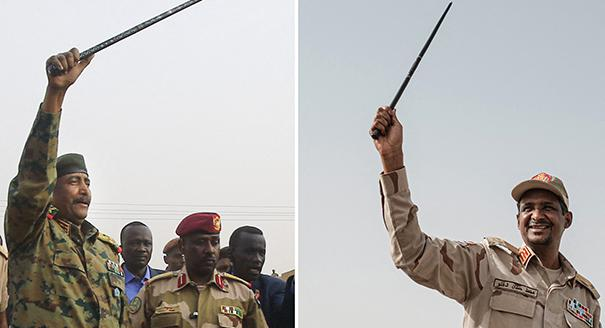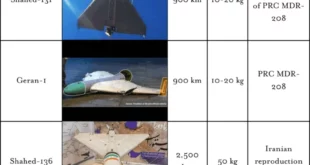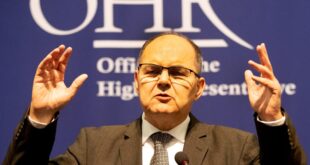The conflict in Sudan is multidimensional, and could generate instability that spreads to the broader region.
Since April 15, fighting between the Sudanese Armed Forces (SAF) and the paramilitary Rapid Support Forces (RSF) across Sudan, especially in the capital Khartoum, has left more than 450 people dead and over 4,000 injured. The fighting erupted after months of tensions between the leaders of both forces, the SAF’s General Abdel-Fattah al-Burhan, who is also the head of Sudan’s Transitional Sovereignty Council, and the RSF’s commander, General Mohammed Hamdan Dagalo, better known as “Hemedti,” who is the council’s deputy head.
The power struggle is multidimensional. The military-led Transitional Sovereignty Council was set up following the April 2019 coup against the former Sudanese president, Omar al-Bashir. Bashir ruled Sudan for three decades and set up an alliance between senior military officers and Islamists, with the balance tilting toward the former in his final years in power. In October 2021, Burhan and Hemedti overthrew a civilian government led by United Nations economist Abdullah Hamdok. Under outside pressure, they reinstated Hamdok soon thereafter, though he only remained in office until January 2022, amid tensions with the military and growing street protests.
The competition between Burhan and Hemedti was apparent from the onset of their role in the post-Bashir era. Burhan belongs to a formal institution, with its visible leaders mostly hailing from the center of Sudan—the Northern State and Khartoum—while Hemedti leads a peripheral militia founded only two decades ago to combat a rebellion in the underdeveloped region of Darfur. The strains between the SAF and RSF were the principal reason for the failed coup against Hamdok.
Nevertheless, the generals maintained their alliance to fend off the protest movement’s growing demands following Hamdok’s initial removal. An early demand of negotiators from the opposition, represented by the civilian-led Forces of Freedom and Change (FFC), was that the RSF be merged with the SAF, which would have meant the end of Hemedti’s influence in the country. In fact, the December 2022 Framework Agreement, which was negotiated to initiate a transition to civilian rule, stated that the RSF would be integrated into the SAF. However, the two parties disagreed over the timeframe of this merger. The SAF sought a transitional period of two years, while the RSF wanted a longer transition of a decade. This added to the ill feelings between the two sides.
Another aspect of the present conflict involves the role of Islamists. FFC members have cited concerns over the return of Islamists to power, which does not seem completely detached from reality. A month before the outbreak of the violence, reports emerged of Islamists taking up arms with the military’s help. Recently, leaders of the former regime were released from Kober Prison in Khartoum. It remains unclear who released them, with the RSF and the SAF accusing each other of doing so. One of those released, however, is Bashir’s onetime senior associate Ahmad Haroun, a leader in the Islamist movement, who is also wanted by the International Criminal Court. A pro-SAF audio message he recorded was widely shared, strengthening fears of an Islamist comeback.**
A third dimension of the struggle between Burhan and Hemedti stems from their background. Hemedti comes from the marginalized Darfur region in the country’s west, while Burhan hails from the northern town of Gandatu, in that part of Sudan that has dominated politics for decades. Although the RSF, previously known as the Janjaweed militia, was established to help quell Darfuri rebel groups, it recruited from tribes that shared a history of marginalization with their victims in Darfur.
Hemedti’s quest for power in the capital is a major shift in the century-old status quo. His leverage over Burhan will ultimately be based on his forces’ ability to overcome the SAF’s superior firepower in an urban setting. The deteriorating humanitarian situation and international pressure are to his advantage, as the longer he can hold his ground in Khartoum, the more likely he will have a leverage at the negotiating table. On the other hand, if the SAF pushes him out of the capital, Hemedti can potentially mobilize Arab tribes in Darfur and beyond, which could threaten Sudan’s unity.
The fighting also works against the lively Sudanese protest movement, which was first led by the Sudanese Professionals Association, then by the Local Resistance Committees. The protests forced the Transitional Sovereignty Council to accept a transitional arrangement after their coup against Hamdok. However, because of the fighting in Khartoum today, the already weakened protest movement will likely lose more momentum as well as the ability to enact reforms. Indeed, any future settlement may well see a power-sharing agreement between the Sudanese military, the RSF, and their civilian cronies.
This outcome could potentially define Sudan’s political landscape, in light of the displacement of large numbers of civilians. Moreover, the ongoing conflict could create uncertainty with regard to the various processes to end armed rebellions across the country. These were also part of the Framework Agreement. Now that the situation has been completely transformed in the country, it is unclear whether these peace processes are ultimately going to be implemented. It is more likely that they will fail, like all previous transitional agreements.
Last but not least, there is a regional dimension to the conflict. Egypt supports the Sudanese military, while the RSF is allegedly receiving backing from a number of regional actors, including the United Arab Emirates, the commander of the Libyan national army, Field Marshal Khalifa Haftar, and the Russian Wagner Group. The RSF’s biggest source of funding is gold mining, which has allowed it to grow tremendously at the expense of much-needed development. Before the coup in 2021, the civilian government was cash-strapped and besieged by a military that controlled a large share of the economy and an RSF whose funding came from one of the country’s most lucrative resources. Regardless of their statements to the contrary, Burhan and Hemedti share an interest in a weakened civilian opposition.
However, if both men continue their military confrontation their grip on power might loosen, and other military actors—either existing rebel groups from the provinces or new ones—could escalate the violence, causing greater displacement of the civilian population. Before the current conflict, Sudan already had 1.1 million refugees and 2.5 million internally displaced persons. The fighting, which has already caused a significant wave of displacement from Khartoum and left 60 percent of health centers in the capital out of service, could quickly bring about a major humanitarian crisis with regional implications.
Any international political intervention should take into consideration the need to restore balance to Sudan’s political scene. This means implementing a more inclusive transition, one that empowers and widens civilian representation as a way forward. Pressuring regional players to engage constructively in the process would also help pave the way for a more durable peace. The alternative could mean enduring instability in Sudan, which could then spread to the country’s neighbors.
 Eurasia Press & News
Eurasia Press & News



